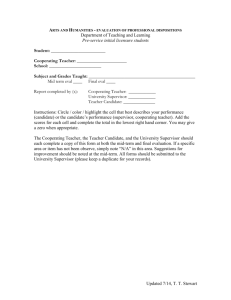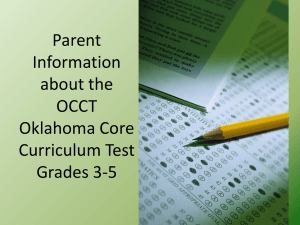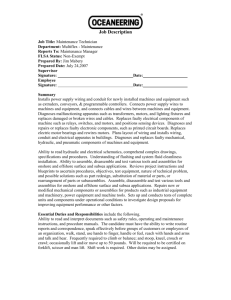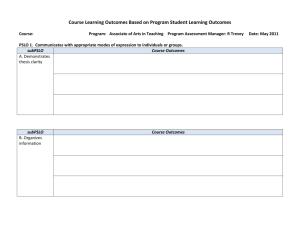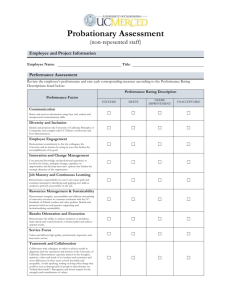CAC Institutional GEO Rubric
advertisement
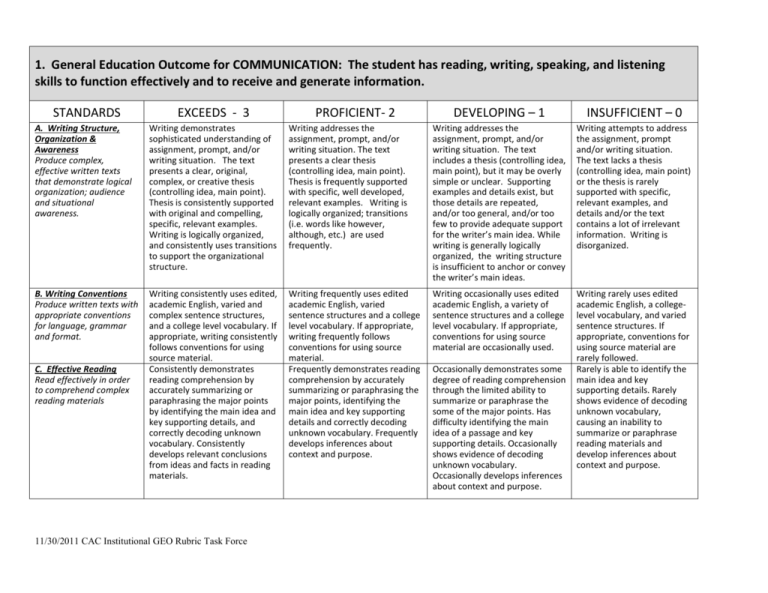
1. General Education Outcome for COMMUNICATION: The student has reading, writing, speaking, and listening skills to function effectively and to receive and generate information. DEVELOPING – 1 INSUFFICIENT – 0 A. Writing Structure, Organization & Awareness Produce complex, effective written texts that demonstrate logical organization; audience and situational awareness. STANDARDS Writing demonstrates sophisticated understanding of assignment, prompt, and/or writing situation. The text presents a clear, original, complex, or creative thesis (controlling idea, main point). Thesis is consistently supported with original and compelling, specific, relevant examples. Writing is logically organized, and consistently uses transitions to support the organizational structure. Writing addresses the assignment, prompt, and/or writing situation. The text presents a clear thesis (controlling idea, main point). Thesis is frequently supported with specific, well developed, relevant examples. Writing is logically organized; transitions (i.e. words like however, although, etc.) are used frequently. Writing addresses the assignment, prompt, and/or writing situation. The text includes a thesis (controlling idea, main point), but it may be overly simple or unclear. Supporting examples and details exist, but those details are repeated, and/or too general, and/or too few to provide adequate support for the writer’s main idea. While writing is generally logically organized, the writing structure is insufficient to anchor or convey the writer’s main ideas. Writing attempts to address the assignment, prompt and/or writing situation. The text lacks a thesis (controlling idea, main point) or the thesis is rarely supported with specific, relevant examples, and details and/or the text contains a lot of irrelevant information. Writing is disorganized. B. Writing Conventions Produce written texts with appropriate conventions for language, grammar and format. Writing consistently uses edited, academic English, varied and complex sentence structures, and a college level vocabulary. If appropriate, writing consistently follows conventions for using source material. Consistently demonstrates reading comprehension by accurately summarizing or paraphrasing the major points by identifying the main idea and key supporting details, and correctly decoding unknown vocabulary. Consistently develops relevant conclusions from ideas and facts in reading materials. Writing frequently uses edited academic English, varied sentence structures and a college level vocabulary. If appropriate, writing frequently follows conventions for using source material. Frequently demonstrates reading comprehension by accurately summarizing or paraphrasing the major points, identifying the main idea and key supporting details and correctly decoding unknown vocabulary. Frequently develops inferences about context and purpose. Writing occasionally uses edited academic English, a variety of sentence structures and a college level vocabulary. If appropriate, conventions for using source material are occasionally used. Writing rarely uses edited academic English, a collegelevel vocabulary, and varied sentence structures. If appropriate, conventions for using source material are rarely followed. Rarely is able to identify the main idea and key supporting details. Rarely shows evidence of decoding unknown vocabulary, causing an inability to summarize or paraphrase reading materials and develop inferences about context and purpose. C. Effective Reading Read effectively in order to comprehend complex reading materials EXCEEDS - 3 11/30/2011 CAC Institutional GEO Rubric Task Force PROFICIENT- 2 Occasionally demonstrates some degree of reading comprehension through the limited ability to summarize or paraphrase the some of the major points. Has difficulty identifying the main idea of a passage and key supporting details. Occasionally shows evidence of decoding unknown vocabulary. Occasionally develops inferences about context and purpose. D. Spoken Discourse & Nonverbal Messages Create understanding through the use of effective and appropriate spoken discourse and nonverbal messages in a variety of contexts. Spoken discourse and nonverbal messages consistently enable shared meaning with others. The speaker consistently accomplishes the desired outcomes for the interaction with messages appropriate to the situation and the audience. Spoken discourse and nonverbal messages frequently enable shared meaning with others. The speaker frequently accomplishes the desired outcomes for the interaction with messages appropriate to the situation and the audience. Spoken discourse and nonverbal messages occasionally enable shared meaning with others. The speaker occasionally accomplishes the desired outcomes for the interaction. Messages are typically appropriate to the situation and the audience. E. Listening & Comprehension Comprehend the intended meaning of complex spoken messages. Perceives the sender’s purpose, attitude, and intended meaning accurately. Consistently recalls important information the sender shares. Employs active listening techniques as appropriate. Perceives the sender’s purpose and attitude accurately. Frequently recalls important information the sender shares. Frequently employs active listening techniques as appropriate. Incompletely perceives the sender’s purpose and attitude. Occasionally recalls important information the sender shares. Occasionally employs active listening techniques as appropriate. 11/30/2011 CAC Institutional GEO Rubric Task Force Spoken discourse and nonverbal messages rarely enable shared meaning with others. The speaker rarely accomplishes the desired outcomes for the interaction. Messages are often inappropriate to the situation and the intended audience. Incompletely or unable to perceive the sender’s purpose or attitude. Rarely recalls information the sender shares minimal. Rarely employs active listening techniques as appropriate. 2. General Education Outcome for CRITICAL THINKING AND ANALYTICAL REASONING – The student has decision-making skills through application of critical thinking and analytical reasoning to effectively define and analyze issues, develop and evaluate solutions, and justify decisions STANDARDS A. Analysis of Issues Define and analyze issues, problems or questions. B. Development and Evaluation Develop and evaluate solutions and/or positions. C. Assessment Effectively communicate assessment of conclusions, implications, and/or consequences. EXCEEDS - 3 PROFICIENT- 2 Articulates well-defined and nuanced issue, problem or question. Applies best strategy to analyze issues, problems or questions. Identifies the complex relationships between and among context, biases and assumptions. Thoroughly accesses, evaluates and analyzes appropriate supporting data/evidence. Establishes complex, welldeveloped argument. Integrates complex perspectives from a multitude of sources, disciplines and/or world views Develops a convincing argument addressing long term considerations, articulates refinement of approach and criteria leading to better solutions. Conclusion addresses the original statement as well as multiple perspectives. Articulates well-defined issue, problem, or question. Applies appropriate strategy to analyze issues, problems or questions. Identifies the influence of context, biases and/or assumptions Articulates limited definition of issue, problem or question. Applies strategy that results in partial analysis of the issues, problems or questions. Identifies some key influences of context, biases and/or assumptions Does not define issue, problem or question. Does not apply a strategy to analyze issues, problems or questions. Does not identify key influences of context, biases and/or assumptions Accesses, evaluates and analyzes appropriate supporting data/evidence. Establishes well-developed argument. Integrates perspectives from a variety of sources, disciplines, and/or world views. Develops a convincing argument addressing some long term conclusions. Conclusion addresses original statement as well as more than one perspective. Accesses, evaluates and/or analyzes limited amounts of supporting data/evidence. Establishes limited argument. Integrates minimal perspectives from alternate sources/disciplines and/or world views. Does not sufficiently access, evaluate and/or analyze supporting data/evidence. Does not develop argument. Does not integrate alternate perspectives. Develops a partially convincing argument. Addresses some considerations. Conclusion seldom addresses original statement and other perspectives. Does not develop a convincing argument. Conclusion does not address implications beyond dichotomous characterization such as yes/no; good/bad; right/wrong. 11/30/2011 CAC Institutional GEO Rubric Task Force DEVELOPING – 1 INSUFFICIENT – 0 3. General Education Outcome for CULTURAL AND ARTISTIC HERITAGE – The student understands and values the ongoing influence of diverse cultural and artistic heritages in our global society. STANDARDS EXCEEDS - 3 PROFICIENT- 2 A. Cultural Literacy Demonstrates an understanding of human cultures. Describe and analyze the nature of intercultural relations within the United States and throughout the world Consistently demonstrates knowledge of the experiences, contributions and world views of many cultures Consistently Identifies and demonstrates effective intercultural communication skills (verbal and nonverbal) , Consistently identifies globalization and how it links and affects the local, regional, and international levels of society. Consistently identifies the mechanisms and norms of global cooperation. Frequently demonstrates knowledge of the experiences, contributions and world views of many cultures. Frequently identifies and demonstrates effective intercultural communication skills (verbal and nonverbal) , Frequently identifies globalization and how it links and affects the local, regional, and international levels of society. Frequently identifies the mechanisms and norms of global cooperation. Occasionally demonstrates knowledge of the experiences, contributions and world views of many cultures. Occasionally identifies and demonstrates effective intercultural communication skills (verbal and nonverbal) , Occasionally identifies globalization and how it links and affects the local, regional, and international levels of society. Occasionally identifies the mechanisms and norms of global cooperation. Rarely demonstrates knowledge of the experiences, contributions and world views of many cultures . Rarely identifies and demonstrates effective intercultural communication skills (verbal and nonverbal) , Rarely identifies globalization and how it links and affects the local, regional, and international levels of society. Rarely identifies the mechanisms and norms of global cooperation. Consistently critically evaluates works of human imagination and thought and articulates an informed personal reaction to works in the arts and/or humanities Frequently identifies significant works of human imagination and thought and articulates a personal reaction to works in the arts and/or humanities Occasionally identifies significant works of human imagination and thought and articulates a limited personal reaction to works in the arts and/or humanities Rarely identifies correctly works of human imagination and thought and articulates a very limited personal reaction to works in the arts and/or humanities B. Global Perspective Demonstrates an understanding of the forces leading to a global society. C. Artistic Heritage Demonstrates an understanding and appreciation of various modes, periods, mediums, media, and artists 11/30/2011 CAC Institutional GEO Rubric Task Force DEVELOPING – 1 INSUFFICIENT – 0 4. General Education Outcome for INDIVIDUAL AND SOCIAL RESPONSIBILITY – The student demonstrates the ability to take responsibility for his/her physical and mental well-being, resolve interpersonal differences, work effectively with others, and to adapt to changes in the workforce. The student will: Cultivate personal integrity. Value the perspectives of others. Contribute to a larger community. STANDARDS EXCEEDS - 3 PROFICIENT- 2 DEVELOPING – 1 INSUFFICIENT – 0 A. Personal Integrity and Core Values Articulates a set of personal core values and beliefs and understand how those influence behavior. Articulates an understanding of the development of core values, beliefs, and attitudes. Consistently expresses a comprehension of how core values, beliefs and attitudes affect and are reflected in one’s own behavior. Analyzes the implications of values, beliefs, and attitudes. Describes the foundations for achieving physical and psychological well-being. Demonstrates and consistently evaluates strategies for ensuring their own well-being. Articulates an understanding of the development of core values, beliefs, and attitudes. Frequently expresses a comprehension of how core values, beliefs and attitudes affect and are reflected in one’s own behavior. Articulates a partial understanding of the development of core values, beliefs, and attitudes. Occasionally expresses a comprehension of how core values, beliefs and attitudes affect and are reflected in one’s own behavior. Students do not demonstrate understanding of their core values, beliefs, and attitudes. Describes the foundations for achieving physical and psychological well-being. Frequently demonstrates and may evaluate strategies for ensuring their own well-being. Describes the foundations for achieving physical and psychological well-being. Occasionally demonstrates strategies for ensuring their own well-being. Rarely describes the foundations for physical and psychological well-being. Does not demonstrate strategies for ensuring their own well-being. C. Perspectives of Others Demonstrates an ability to see things from the perspectives of others and uses that ability to interact effectively. Consistently understands differing opinions, works effectively with others and resolves interpersonal differences. Frequently understands differing opinions, works effectively with others and resolves interpersonal differences Occasionally understands differing opinions, works effectively with others and resolves interpersonal differences. Rarely understands differing opinions, works ineffectively with others and often fails to resolves interpersonal differences D. Contribute to Larger Community Demonstrates an understanding of community engagement and involvement in a larger community. Defines connections between individuals and society and show leadership by their activities in the community. Consistently analyzes the effects and importance of individual contributions. Defines connections between individuals and society and demonstrate concern for an involvement in the community. Frequently analyzes the effects and importance of individual contributions. Defines connections between individuals and society and demonstrate concern for an involvement in the community. Describes the importance of individual contributions. Rarely makes connections between individuals and society. Rarely demonstrates concern for the community. B. Personal Well-Being Understands the importance of physical and psychological wellbeing. 11/30/2011 CAC Institutional GEO Rubric Task Force 5. General Education Outcome for INFORMATIONAL/TECHNOLOGICAL LITERACY – The student has technological knowledge and demonstrates proficiency in applying emerging technologies and understands the influence and effects of technology on society and the impact on our environment. The student uses technology to evaluate, synthesize, and produce information. STANDARDS EXCEEDS - 3 PROFICIENT- 2 DEVELOPING – 1 INSUFFICIENT – 0 A. Access of Information Locates and accesses suitable information which fulfills the information need. Critically defines the scope of the research question or topic. Accesses information using effective, well-designed search strategies. Sources directly relate to the topic and are varied in type. Effectively defines the scope of the research question or topic. Accesses information using a variety of search strategies. Sources frequently relate to topic and are varied in type. Incompletely defines the scope of the research question or topic (parts are missing; it is too broad or too narrow, etc). Accesses information using simple search strategies. Sources may be only partially related to topic and/or too similar in terms of content. Types of sources are occasionally varied. Occasionally identifies credible sources by evaluating authorship, bias, relevancy and accuracy. Incompletely defines the scope of the research question or topic. Accesses information randomly. Sources are only partially related to and/or may not be related to the topic. Types of sources are limited. B. Evaluation of Information Critically evaluates information sources Consistently identifies credible sources by evaluating authorship, bias, relevancy and accuracy. Frequently identifies credible sources by evaluating authorship, bias, relevancy and accuracy. C. Use of Information Uses information effectively and ethically Consistently synthesizes sources to support purpose and main idea/thesis. Consistently uses proper citation conventions (quotes, paraphrases, style, etc.,) and citation formats. Frequently synthesizes sources to support purpose and main idea/thesis. Frequently uses proper citation conventions (quotes, paraphrases, style, etc.,) and citation formats. Occasionally synthesizes sources to support purpose and main idea/thesis. Occasionally uses proper citation conventions (quotes, paraphrases, style, etc.,) and citation formats. Rarely synthesizes sources to support purpose and main idea/thesis. Rarely uses proper citation conventions (quotes, paraphrases, style, etc.,) and citation formats. D. Knowledge of Technology Demonstrates that technology involves systems which are groups of interrelated components. Effectively applies the operating principles of a specific technology. Explains the operating principles of specific technology. Lists the operating principles of a specific technology. Identifies a specific technology but fails to list the operating principles. E. Impact of Technology Understands the interrelationships between technology and the environment. Analyzes the potential effects of an emerging technology on individuals, society and the environment. Examines the effects of an existing technology on individuals, society and the environment. Identifies some interrelationships between technology and individuals, society and the environment. Lists critical technologies but fails to identify their relationships with individuals, society or the environment. F. Use of Technology Effectively uses technology to achieve the desired end. Consistently uses technology to effectively evaluate, synthesize or produce a desired product. Frequently uses technology to effectively evaluate, synthesize or produce a desired product. Occasionally uses technology to evaluate, synthesize or produce a desired product. Rarely uses technology effectively to evaluate, synthesize or produce a desired product. 11/30/2011 CAC Institutional GEO Rubric Task Force Rarely identifies credible sources by evaluating authorship, bias, relevancy and accuracy. 6. General Education Outcome for MATHEMATICAL/SCIENTIFIC INQUIRY AND ANALYSIS – The student applies the concepts, methods, and principles of mathematics and the sciences. STANDARDS EXCEEDS - 3 PROFICIENT- 2 DEVELOPING – 1 INSUFFICIENT – 0 A. Scientific Concepts The student demonstrates knowledge and application of scientific concepts. Consistently gives evidence of a complete understanding of, and ability to apply, the synthesis of related concepts. Frequently gives evidence of having a complete understanding of, and ability to apply, the appropriate concept. Occasionally gives evidence of having an incomplete understanding of, and ability to apply, the appropriate concept. Does not demonstrate any knowledge or application of the appropriate concept B. Scientific Methods The student demonstrates analysis and application of the methods of scientific inquiry Consistently gives evidence of a complete understanding of, and ability to apply, the synthesis of related methods. Frequently gives evidence of having a complete understanding of, and ability to apply, the appropriate method. Occasionally gives evidence of having an incomplete understanding of, and ability to apply, the appropriate method. Does not demonstrate any knowledge or application of the appropriate method. C. Scientific Principles The student demonstrates knowledge and application scientific principles. Consistently gives evidence of a complete understanding of, and ability to apply, the synthesis of related principles. Frequently gives evidence of having a complete understanding of, and ability to apply, the appropriate principle. Occasionally gives evidence of having an incomplete understanding of, and ability to apply, the appropriate principle. Does not demonstrate any knowledge or application of the appropriate principle D. Mathematical Model Development Identifies relevant data and uses technology as necessary to develop an appropriate mathematical or statistical model to address a problem. Consistently develops the most appropriate mathematical or statistical model for a given situation. Frequently selects an appropriate mathematical or statistical model for a given situation. Occasionally recognizes an appropriate mathematical or statistical model for a given situation. Rarely recognizes an appropriate mathematical or statistical model for a given situation. E. Mathematical Computation Accurately carries out numerical computation in order to solve problems using technology when appropriate. Consistently performs necessary calculations, using technology when appropriate, and obtains correct results while solving a problem. Frequently performs necessary calculations, using technology when appropriate, and obtains correct results while solving a problem. Occasionally performs calculations correctly while solving a problem. Rarely performs calculations correctly while solving a problem. F. Mathematical Interpretation Analyzes mathematical or statistical results. Consistently draws reasonable conclusions based on numerical and graphical information. Frequently draws reasonable conclusions based on numerical and graphical information. Occasionally draws reasonable conclusions based on numerical and graphical information. Rarely draws reasonable conclusions based on numerical and graphical information. 11/30/2011 CAC Institutional GEO Rubric Task Force 11/30/2011 CAC Institutional GEO Rubric Task Force

